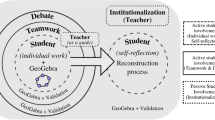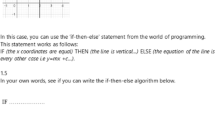Abstract
The study focused on how university students constructed proof of the Fundamental Theorem of Calculus (FTC) starting from their argumentations with dynamic mathematics software in collaborative technology-enhanced learning environment. The participants of the study were 36 university students. The data consisted of participants’ written productions, dynamic materials, and the transcriptions of the participants’ argumentations for the selected groups. The analysis was based on the integration of cK¢ model and Toulmin’s model. The analysis showed that the collaborative technology-enhanced learning environment helped the participants to interpret the Mean Value Theorem (MVT) for definite integrals geometrically and use this interpretation for the proof of the FTC. They constructed proof the FTC using geometric, empirical, and symbolic conceptions involved in their argumentations supporting their conjecture about the evolution of the derivative, the MVT, and limit idea. The construction of the connections between algebraic and geometric representations regarding the FTC in a social interaction-communication process helped them to move from a geometric perspective to a theoretical perspective while constructing proof of the FTC. The mediation role of dynamic mathematics software GeoGebra provided them to construct multiple representations and verify conjectures in producing deductive argumentations about the proof of the FTC. The emergence of the social norms in classroom microculture with this integration method contributed to the evolution of participants’ representations and their reasoning on the FTC. Additionally, they made connections between the conclusions of the FTC and the differential equation, but they did not mention the continuity condition for proof of the FTC.






















Similar content being viewed by others
References
Balacheff, N. (2013). cK¢, a model to reason on learners' conceptions. In M. Martinez & A. Castro Superfine (Eds.), Proceedings of the 35th annual meeting of the North American Chapter of the International Group for the Psychology of Mathematics Education (pp. 2–15). Chicago: University of Illinois at Chicago.
Balacheff, N., & Gaudin, N. (2010). Modeling students’ conceptions: The case of function. In F. Hitt, D. Holton, & P. Thompson (Eds.), Research in College Mathematics Education VII (pp. 207–234). American Mathematical Society.
Boero, P., Garuti, R., & Mariotti, M. A. (1996). Some dynamic mental processes underlying producing and proving conjectures. Proceedings of the 20th conference of the international group for the psychology of mathematics education PME-XX, vol. 2, (pp. 121–128). Valencia.
Bressoud, D. M. (2011). Historical reflections on teaching the Fundamental Theorem of Integral Calculus. The American Mathematical Monthly, 118(2), 99–115.
Carlson, M. P., Persson, J., & Smith, N. (2003). Developing and connecting calculus students’ notions of rate-of-change and accumulation: The fundamental theorem of calculus. In N. Patemen (Ed.), Proceedings of the 2003 Meeting of the International Group for the Psychology of Mathematics Education-North America (Vol 2, pp. 165–172). Honolulu, HI: University of Hawaii.
Carlson, M., Jacobs, S., Coe, E., Larsen, S., & Hsu, E. (2002). Applying covariational reasoning while modeling dynamic events: A framework and a study. Journal for Research in Mathematics Education, 33(5), 352–378.
Chazan, D. (1993). Instructional implications of students’ understanding of the differences between empirical verification and mathematical proof. In J. L. Schwartz, M. Yerushalmy, & B. Wilson (Eds.), The geometric supposer: What is it a case of?. Hillsdale, NJ: Erlbaum.
Clark-Wilson, A., Robutti, O., & Sinclair, N. (2014). The mathematics teacher in the digital era: An international perspective on technology focused professional development (Vol. 2, Mathematics Education in the Digital Era). Dordrecht: Springer.
Cobb, P., Yackel, E., & Wood, T. (1989). Young children’s emotional acts while doing mathematical problem solving. In D. B. McLeod & V. M. Adam (Eds.), Affect and mathematical problem solving: A new perspective (pp. 117–148). Springer-Verlag.
Conner, A., Singletary, L. M., Smith, R. C., Wagner, P. A., & Francisco, R. T. (2014). Teacher support for collective argumentation: A framework for examining how teachers support students’ engagement in mathematical activities. Educational Studies in Mathematics, 86(3), 401–429.
Edwards, L. D. (1997). Exploring the territory before proof: Student’s generalizations in a computer microworld for transformation geometry. International Journal of Computers for Mathematical Learning, 2(3), 187–215.
Eggs, E. (1994). Grammaire du discours argumentatif. Le topique, le générique, le figuré. Ed. Kimé, Paris.
Falcade, R., Laborde, C., & Mariotti, M. A. (2007). Approaching functions: Cabri tools as instruments of semiotic mediation. Educational Studies in Mathematics, 66(3), 317–333.
Fiallo, J., & Gutiérrez, A. (2017). Analysis of the cognitive unity or rupture between conjecture and proof when learning to prove on a grade 10 trigonometry course. Educational Studies in Mathematics, 96(2), 145–167.
García-García, J., & Dolores-Flores, C. (2018). Intra-mathematical connections made by high school students in performing Calculus tasks. International Journal of Mathematical Education in Science and Technology, 49(2), 227–252.
García-García, J., & Dolores-Flores, C. (2020). Exploring pre-university students’ mathematical connections when solving Calculus application problems. International Journal of Mathematical Education in Science and Technology. Advance online publication. https://doi.org/10.1080/0020739X.2020.1729429
Harel, G. (2001). The development of mathematical induction as a proof scheme: A model for DNR-based instruction. In S. Campbell, & R. Zazkis (Eds.), Learning and Teaching Number Theory. New Jersey: Ablex Publishing Corporation
Healy, L., & Hoyles, C. (2002). Software tools for geometrical problem solving: Potentials and pitfalls. International Journal of Computers for Mathematical Learning, 6(3), 235–256.
Hitt, F. (2011). Construction of mathematical knowledge using graphic calculators (CAS) in the mathematics classroom. International Journal of Mathematical Education in Science and Technology, 42(6), 723–735.
Hitt, F., & González-Martín, A. (2015). Covariation between variables in a modelling process: The ACODESA (collaborative learning, scientific debate and self-reflexion) method. Educational Studies in Mathematics, 88(2), 201–219.
Hitt, F., Saboya, M., & Cortés-Zavala, C. (2017). Rupture or continuity: The arithmetico-algebraic thinking as an alternative in a modelling process in a paper and pencil and technology environment. Educational Studies in Mathematics, 94(1), 97–116.
Hohenwarter, J., & Hohenwarter, M. (2013). Introduction to GeoGebra. Retrieved from https://static.geogebra.org/book/intro-en.pdf. Accessed 26 Jan 2017
Jeannotte, D., & Kieran, C. (2017). A conceptual model of mathematical reasoning for school mathematics. Educational Studies in Mathematics, 96(1), 1–16.
Jones, S. R. (2018). Prototype images in mathematics education: The case of the graphical representation of the definite integral. Educational Studies in Mathematics, 97(3), 215–234.
Kleiner, I. (2001). History of the infinitely small and the infinitely large in calculus. Educational Studies in Mathematics, 48(2–3), 137–174.
Knipping, C. (2008). A method for revealing structures of argumentation in classroom proving processes. ZDM - the International Journal on Mathematics Education, 40(3), 427–441.
Krummheuer, G. (1995). The ethnography of argumentation. In P. Cobb & H. Bauersfeld (Eds.), The emergence of mathematical meaning: Interaction in classroom cultures (pp. 229–269). Lawrence Erlbaum Associates.
Lithner, J. (2008). A research framework for creative and imitative reasoning. Educational Studies in Mathematics, 67(3), 255–276.
Mahir, N. (2009). Conceptual and procedural performance of undergraduate students in integration. International Journal of Mathematical Education in Science and Technology, 40(2), 201–211.
Marrades, R., & Gutiérrez, A. (2000). Proofs produced by secondary school students learning geometry in a dynamic computer environment. Educational Studies in Mathematics, 44(1/2), 87–125.
McMillan, J., & Schumacher, S. (2010). Research in education: Evidence-based inquiry (7th ed.). Pearson.
Pedemonte, B. (2002). Etude didactique et cognitive des rapports de l’argumentation et de la démonstration dans le apprentisage des mathématiques. (Doctoral dissertation). Université Joseph Fourier-Grenoble I, Grenoble, France.
Pedemonte, B. (2007). How can the relationship between argumentation and proof be analysed? Educational Studies in Mathematics, 66(1), 23–41.
Pedemonte, B., & Balacheff, N. (2016). Establishing links between conceptions, argumentation and proof through the ckȼ-enriched Toulmin model. The Journal of Mathematical Behavior, 41, 104–122.
Pedemonte, B., & Reid, D. (2011). The role of abduction in proving processes. Educational Studies in Mathematics, 76(3), 281–303.
Prediger, S., Bikner-Ahsbahs, A., & Arzarello, F. (2008). Networking strategies and methods for connecting theoretical approaches: First steps towards a conceptual framework. ZDM-the International Journal on Mathematics Education, 40(2), 165–178.
Radford, L. (2003). Gestures, speech, and the sprouting of signs: A semiotic-cultural approach to students’ types of generalization. Mathematical Thinking and Learning, 5(1), 37–70.
Radford, L. (2013). Three key concepts of the theory of objectification: Knowledge, knowing, and learning. Journal of Research in Mathematics Education, 2(1), 7–44.
Segadas Vianna, C. (1998). Students’ understanding of the fundamental theorem of calculus: An exploration of definitions, theorems and visual imagery. (Unpublished doctoral dissertation). Institute of Education, University of London, UK.
Stephan, M., & Rasmussen, C. (2002). Classroom mathematical practices in differential equations. Journal of Mathematical Behavior, 21, 459–490.
Swidan, O. (2020). A learning trajectory for the fundamental theorem of calculus using digital tools. International Journal of Mathematical Education in Science and Technology, 51(4), 542–562.
Swidan, O., Sabena, C., & Arzarello, F. (2020). Disclosure of mathematical relationships with a digital tool: A three layer-model of meaning. Educational Studies in Mathematics, 103(1), 83–101.
Thomas, G. B., Weir, M. D., & Hass, J. R. (2010). Thomas Calculus (12th ed.). Pearson Education Inc.
Thompson, P. (1994). Images of rate and operational understanding of the fundamental theorem of calculus. Educational Studies in Mathematics, 26(2/3), 229–274.
Thompson, P. W., & Silverman, J. (2008). The concept of accumulation in calculus. In M. P. Carlson & C. Rasmussen (Eds.). Making the Connection: Research and Teaching in Undergraduate Mathematics Education (pp. 43–52). MAA, Washington, DC: Mathematical Association of America.
Thompson, P. W., Byerley, C., & Hatfield, N. (2013). A Conceptual Approach to Calculus Made Possible by Technology. Computers in the Schools, 30(1–2), 124–147.
Toulmin, S. E. (2003). The uses of argument (updated edition of the 1958 book). Cambridge University Press.
Verzosa, D., Guzon, A. F., & De laspeñas, Ma. L. A. N. . (2014). Using dynamic tools to develop an understanding of the fundamental ideas of calculus. International Journal of Mathematical Education in Science and Technology, 45(2), 190–199.
Yackel, E. (2001). Explanation, justification and argumentation in mathematics classrooms. In: M. van den Heuvel-Panhuizen (Ed.), Proceedings of the 25th conference of the International Group for the Psychology of Mathematics Education (Vol. 1, pp. 9–24). Utrecht, The Netherlands: Freudenthal Institute.
Zengin, Y. (2017). The effects of GeoGebra software on preservice mathematics teachers’ attitudes and views toward proof and proving. International Journal of Mathematical Education in Science and Technology, 48(7), 1002–1022.
Zengin, Y. (2018). Examination of the constructed dynamic bridge between the concepts of differential and derivative with the integration of GeoGebra and the ACODESA method. Educational Studies in Mathematics, 99(3), 311–333.
Zengin, Y. (2019). Development of mathematical connection skills in a dynamic learning environment. Education and Information Technologies, 24(3), 2175–2194.
Acknowledgements
I would like to thank Gülay Bozkurt for her valuable comments on the paper, and for carefully proofreading the paper.
Author information
Authors and Affiliations
Corresponding author
Additional information
Publisher's note
Springer Nature remains neutral with regard to jurisdictional claims in published maps and institutional affiliations.
Appendix
Appendix
Rights and permissions
About this article
Cite this article
Zengin, Y. Construction of proof of the Fundamental Theorem of Calculus using dynamic mathematics software in the calculus classroom. Educ Inf Technol 27, 2331–2366 (2022). https://doi.org/10.1007/s10639-021-10666-1
Received:
Accepted:
Published:
Issue Date:
DOI: https://doi.org/10.1007/s10639-021-10666-1




